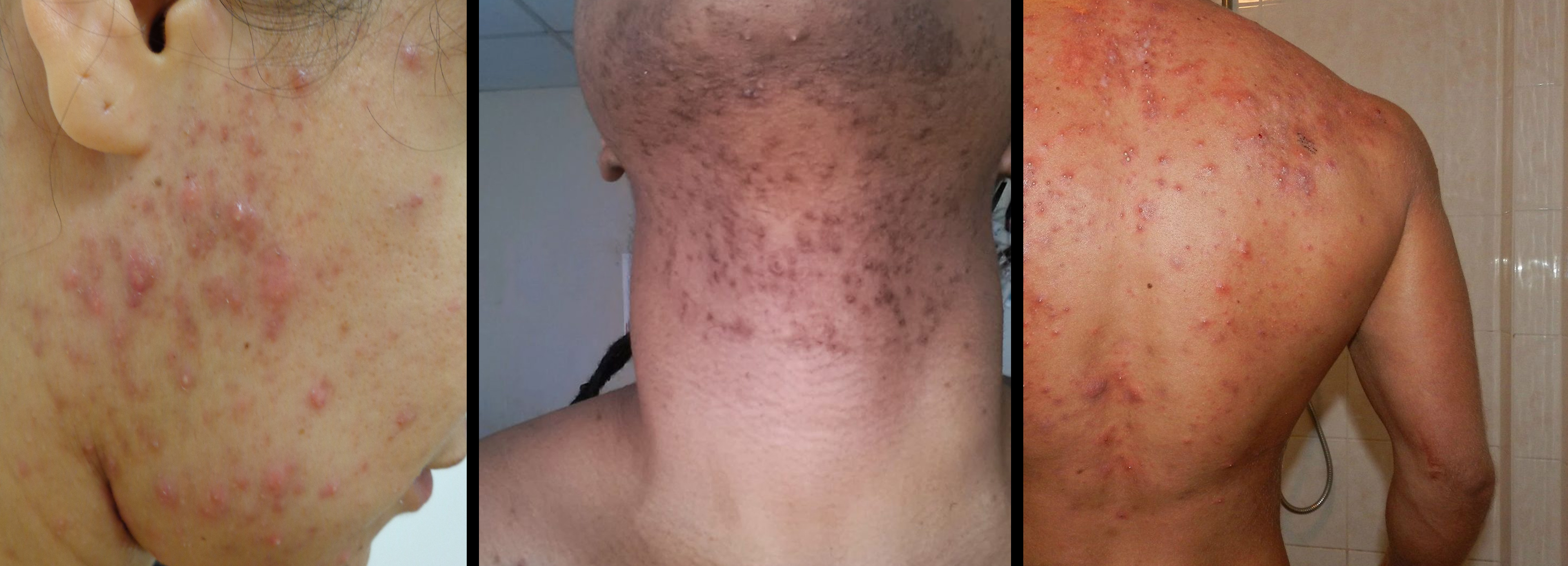Think pimples are a relic of your teenage years — along with bad hair, SAT stress
and prom disasters? Unfortunately, an estimated 25% of men and 50% of women
between the ages of 25 and 40 struggle with various forms of acne. While adult
acne is rarely a serious medical problem, it can cause pain, embarrassment and
even depression. But whether bad skin is a continuation of adolescent-era problems
or you’re struggling with breakouts for the first time in your 20s, 30s or beyond, don’t
despair. The good news is that there are myriad treatment options that can quickly
improve the way you look — and feel. It’s just a matter of finding the right regimen.
Cause combo

Contrary to popular belief, acne at any age is not the result of dirt or poor hygiene — or
eating too much chocolate. Instead, the condition is caused by a combination of factors
that can include genetics and hormonal changes as well as environmental triggers
such as stress, oily makeup and pollution. “Women have hormonal fluctuations all the
time related to their menstrual cycle, going on or off the [birth control] pill, pregnancy,
giving birth, perimenopause and menopause … and every time there’s a hormonal
change, it can cause breakouts,” explains Diane Berson, M.D., a clinical assistant
professor of dermatology at the Weill Medical College of Cornell University in New
York. Berson notes that stress works in a similar way. “When you’re under stress, the
adrenal gland responds by producing adrenalin and male hormones called androgens,
which stimulate oil production and can also lead to breakouts,” she says. The result of
this hormonal influence is that while acne is usually more severe for adolescent males,
it is much more common among adult women. And while teenagers tend to get pimples
in the T zone (forehead, nose and chin region), adults tend to break out in what Berson
calls “the hormonal area,” or lower part of the face that includes the cheeks, jaw line
and neck. In addition, adolescents typically develop blackheads and whiteheads that
result from oily, clogged skin, while women more often have to deal with an inflamed
pink, tender type of pimple known as a papule that’s due to hormones or stress.
Let’s talk treatment
With a wide range of acne therapies available everywhere from late-night infomercials
and packed drugstore shelves to the dermatologist’s office, it’s important to make
informed choices. If you have mild acne or occasional breakouts, the drug store is
a great place to start. There are lots of good over-the-counter lotions, gels, creams
and medicated pads that contain proven ingredients such as benzoyl peroxide (which
reduces bacteria on the skin), salicylic acid (which unclogs pores) and sulfur.
Even teen standby Clearasil isn’t out of the question for adult use, says Alicia Barba,
M.D., a board-certified dermatologist in private practice in Miami. She adds that such
products can be tough on older skin, which is typically drier and more sensitive. So
hydrating with an oil-free, noncomedogenic moisturizer (that won’t block pores) is
important. If you find that over-the-counter options aren’t helping after a month or two,
you may want to visit a dermatologist who can evaluate your skin and help tailor your
treatment. “One shoe doesn’t fit all sizes,” says Sandra Read, M.D, a Washington,
D.C., dermatologist and member of the board of directors of the American Academy of
Dermatology. She explains that a man with chronic cystic acne on his back requires
completely different care than a woman who’s having stress-induced breakouts related
to her upcoming wedding. “What type of skin do you have? What type of acne do
you have? What’s your lifestyle? Where are you in your life cycle? Expert guidance
can really help,” Read adds. Most dermatologists begin by prescribing one or more medications. Choices include:
- Oral antibiotics like tetracycline and doxycycline help stop or slow the growth of
bacteria and reduce inflammation. - Topical antimicrobials inhibit the growth of Propionibacterium acnes (P. acnes) and help prevent breakouts. Examples include azelaic acid, prescription-strength benzoyl peroxide and antibiotics like clindamycin and erythromycin.
- Topical retinoids such as Retin-A (tretinoin) and Differin (adapalene) are vitamin
A derivatives that act like exfoliants, unclogging pores and existing pimples and
allowing other topical drugs to enter the skin and work more effectively. - Accutane (isotretinoin) is a potent oral retinoid typically used for severe cystic or
nodular acne that hasn’t responded to other treatments. - Oral contraceptives help regulate hormones and can work well for women who
experience premenstrual acne flare-ups.
All of these treatments can be used separately or in various combinations that
make them more successful and long-lasting — such as when a topical retinoid is
prescribed alongside a topical antimicrobial or when oral and topical antibiotics are
used simultaneously. Additional therapies available from your dermatologist or even
a licensed aesthetician at a spa can significantly improve adult acne as well, especially
when used in conjunction with an oral or topical regimen. They include:
- Extractions or acne surgery — essentially a safe, sterile version of pimplepopping
that should not be tried at home. - Microdermabrasion, which removes upper layers of the skin, can help prevent
acne and improve the appearance of scarring. - Chemical peels with salicylic acid or glycolic acid unclog pores, open
blackheads and whiteheads, and stimulate the growth of new, healthy skin. - If you’ve got a distractingly huge red pimple on the middle of your nose, a
corticosteroid injection should make it disappear overnight — if not the very
same afternoon. - Various cutting-edge laser and light treatments combat acne by attacking
bacteria, oil production and inflammation. Whether it’s a straight laser applied to
bumps or blue-light photodynamic therapy, which can be administered alone or
with alpha-linolenic acid (ALA), such treatments can be effective. However, they
are also expensive — costing $500 and more per session, with multiple visits
required.
Skin care
It’s important to take proper care of your skin as you get older, particularly if you’re
struggling with acne. Some basic tips that can make a big difference:
- Be gentle. Use a mild cleanser to gently wash your face twice a day, and limit
the number of products you use on your skin. - Stay out of the sun. It ultimately makes acne worse and increases the risk of
skin cancer and wrinkles. Many acne medications also make your skin more
sensitive to sunlight. - No picking. Do not pick, pop or squeeze pimples, all of which increase the risk
of scarring. - Cosmetics 101. Only use only oil-free, noncomedogenic makeup.
No matter what, don’t let bad skin get you down. While it’s true that there’s no cure for
acne whether you’re 13 or 35, you can definitely control the condition with proper care
and targeted treatment.
By Carolyn Kleiner Butler
Content provided by Revolution Health Group

